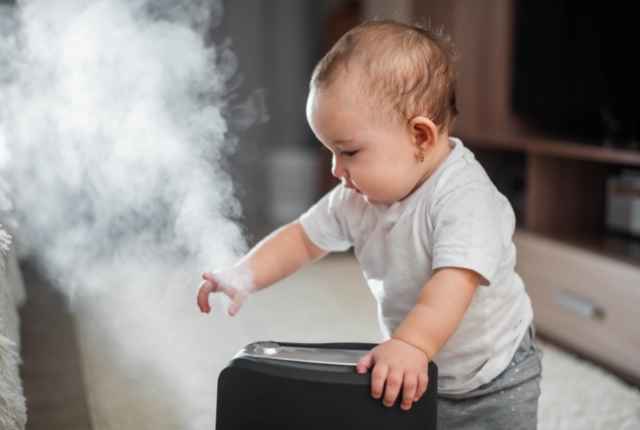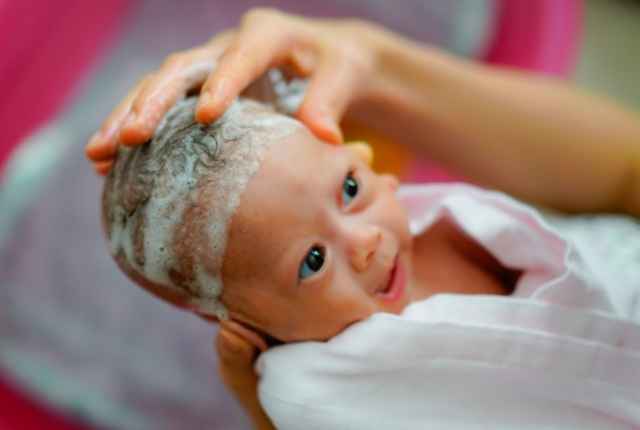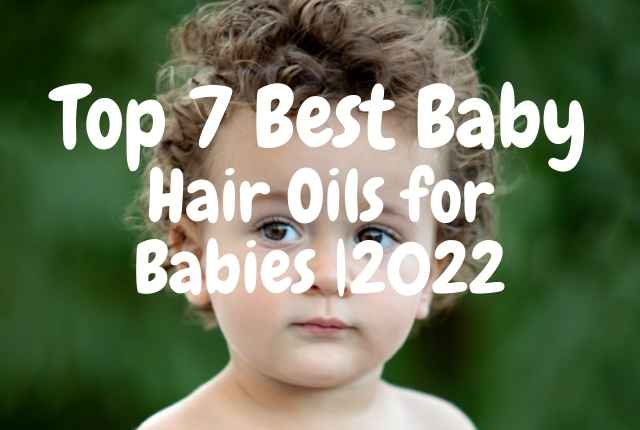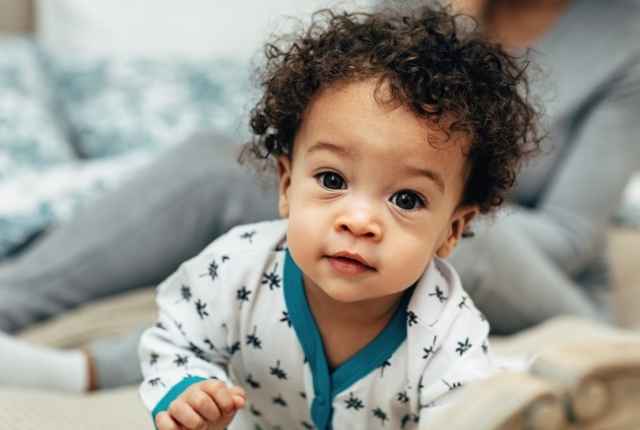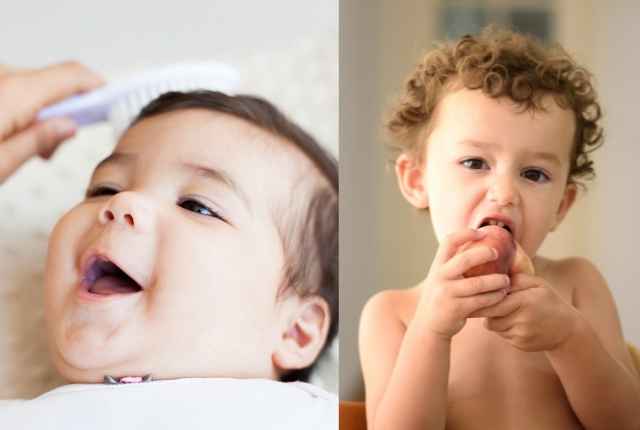Humidifiers are helpful to babies when the air is dry. They also provide a lot of benefits for your baby.
However they can be risky if not placed properly.
If you are looking to find the answer to the question “how close should humidifier be to baby?” please read on
In this article, I will discuss where to place a humidifier and how close it should be to the baby…
As a parent, I dread the effects of low humidity and dry air on my little ones.
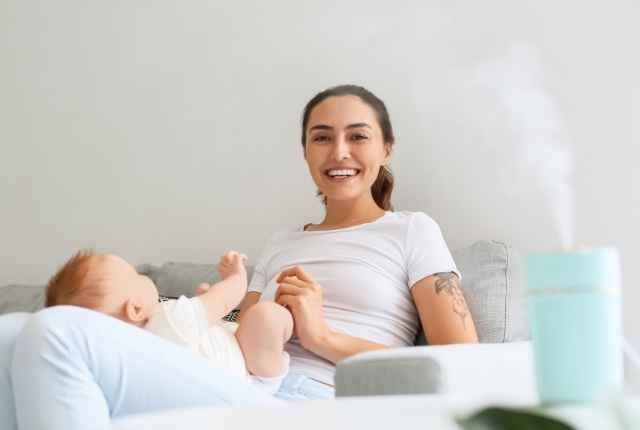
It’s during this season that they become more vulnerable to dry skin, a stuffy nose ( nasal congestion), and cracked lips.
One of the ways I use to mitigate conditions caused by low humidity level is by placing a humidifier in my baby’s room.
Humidifiers work by forcing vapor or steam out through a sprout.
The steam increases the humidity level in a room, and when breathed, it moistens the airways and alleviates the symptoms, as mentioned earlier.
Another reason why I like humidifiers is that they make my baby get better sleep. How? By keeping the nasal passages moist and less sticky, it makes children breathe easily at night, enabling them to get a peaceful sleep.
Additionally, humidifiers prevent dry skin and lower the risk of eczema, since it keeps the skin moist. Interestingly, some babies find the sound produced by vaporizers pleasant.
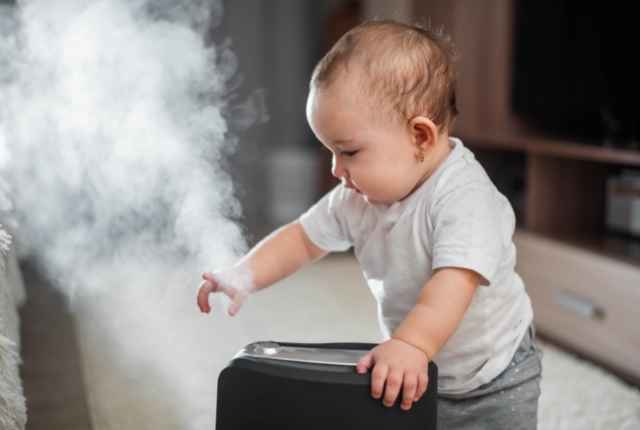
Hey! By the way… any links on this page that lead to products on Amazon are affiliate links and I earn a commission if you make a purchase.
Thanks in advance – I really appreciate it!
Note: According to the American Academy of Pediatrics, the best types of humidifiers for nurseries are the cool mist humidifiers.
CLICK ON IMAGE FOR MORE INFO
You should avoid using Warm mist humidifiers for babies.
With that out of the way, let’s now get into how far a humidifier should be to the baby.
What is the safe distance to keep them and how to find the perfect spot.
Table of Contents
- How far should humidifier be from baby?
- Humidifier Placement Tips
- Risks of Putting a Humidifier Too Close to a Baby
- Should I Use Additives?
- Humidifier Types: Which One Is Right for Your Baby’s Room?
- The Ideal Humidity Level for a Baby’s Room
- Proper Humidifier Cleaning and Maintenance
- Safety Features to Look for When Purchasing a Humidifier
- Indoor Plants and Humidity: A Natural Solution
- Alternatives to Humidifiers for Maintaining Humidity
- Common Issues with Humidifiers and How to Address Them
- Proper Room Ventilation: The Key to Healthy Humidity Levels
- Vaporizers vs. Humidifiers: Which Is Best for Your Baby’s Room?
- Adjusting Humidifier Settings Based on Outdoor Weather Conditions
- Final Words
- READ NEXT
How far should humidifier be from baby?
A humidifier should be placed at least three feet from the baby’s crib, but no farther than five feet.
This distance ensures that the mist doesn’t fall on the bed or the infant, preventing further complications.
It’s also advisable to place the humidifier centrally, as this helps the vapor spread evenly across the room.
Ensure that you keep it off the floor, preferably on a chair, a dresser, or a table.
Also, make sure the humidifier is the right size depending on the room’s size.
For instance, don’t use a small humidifier in a spacious nursery or a large humidifier in a small nursery.
No products found.CLICK ON IMAGE FOR MORE INFO
No products found.CLICK ON IMAGE FOR MORE INFO
Using a large humidifier in a small nursery may add excess moisture into the air which can be detrimental to the baby.
On the other hand, a small humidifier in a spacious nursery may not produce enough vapor or mist.
There are also certain features that dictate how close a humidifier should be placed.
For instance, a humidifier with a 360-degree rotating nozzle and a humidity sensor can be kept closer since there is no risk of producing excess vapor and there is even distribution of mist.
Apart from the distance, another consideration is how high should the humidifier be from the ground.
Generally, a humidifier should be about 2 feet from the ground unless it’s a standing type.
If you are placing it on a surface make sure the surface isn’t affected easily by water.
Like don’t place them on a wooden surface.
Humidifier Placement Tips
Here are some tips for positioning your humidifier for maximum effectiveness.
1 When Sleeping
I don’t particularly appreciate placing the humidifier too close to the bed at sleep time.
This is because the moisture level might be too much if the equipment is near your sleeping area.
Also, babies who are light sleepers find the noise level produced by this equipment uncomfortable.
2 Avoid Sunlight
It would be best if you placed your humidifier away from direct sunlight.
The heat from the sun’s rays provides the optimal condition for the growth of algae and bacteria, increasing the rate at which the water inside your humidifier spoil.
3 Keep Off the Floor
The water droplets from the humidifier can promote bacteria and mold growth if they fall on your carpet.
For this reason, ensure that you keep this equipment at least two feet off the floor.
You can do this by placing a waterproof material on its base, as this also prevents damage caused by accidental water spills.
Alternatively, you can place the humidifier on a table or a chair.
Risks of Putting a Humidifier Too Close to a Baby
While they’re beneficial, putting humidifiers too close to your baby can have adverse effects on their health.
Wrong placement, applying incorrect settings, failing to maintain the machine, and using low-quality all put your kid’s wellbeing at risk.
Here are the effects of placing a humidifier too close to your baby.
1 Allergy
If your baby experiences recurring allergies, it’s wise to examine the humidifier.
Many people are unaware that this equipment can cause allergies since alleviating it is one of its common uses.
When you apply high humidity settings, dust mites proliferate in your bedroom, increasing the risk of allergic reactions.
A humidifier also causes allergies if it’s not cleaned regularly.
As such, it’s essential to use the correct humidity settings and clean them regularly.
Using a humidifier in a stuffy room causes allergies, which manifests itself through persistent coughs, skin rashes, sneezing, and sniffles in babies.
In severe cases, it can cause asthma, a condition characterized by constricted airways.
If your baby is asthmatic, ensure that your room has adequate ventilation before starting a humidifier.
2 Bacteria
High humidity and dirt promote bacterial growth.
Bacteria cause infections and can hurt your kid’s health, especially because they have vulnerable immunity.
Through experience, I can attest that humidifiers labeled as ‘antibacterial’ are ineffective.
Indeed, this is an inclusion meant to coax unknowing parents into buying such products.
If you want close to zero bacterial emissions, evaporative wick vaporizers are your best bet.
No products found.CLICK ON IMAGE FOR MORE INFO
That said, you’ll need to replace the evaporative wick regularly to keep the equipment in pristine condition.
3 Mold
Failing to clean your humidifier regularly causes the growth of mold.
When you turn on such equipment, the air it expels contains mold particles.
These particles are a health risk to you and your kids and cause significant discomfort if you are allergic.
Additionally, applying high humidity settings on dirty equipment can result in mold particles sticking on other surfaces of your bedroom.
After extended periods, these particles turn into the mold that attacks porous surfaces such as wooden furniture and ceilings, floors.
The signs of mold-infested furniture are black patches.
Over time, the mold softens the wood and eventually breaks it down.
To prevent this problem of unwanted mold, varnish your wood, and more importantly, clean your humidifier regularly.
4 Accidents
Besides health issues, putting a humidifier too close to your baby can cause accidents.
These include accidental water spills, burns, electrocution, and tripping on wires and electrical cords.
5 Accidental Water Spills
If your baby is as playful as mine, you need to worry about accidental water spills.
The most common cause of these spills, however, is overfilling your humidifier.
Other causes include a blocked drainage tube and a clogged evaporator pad, which result from the accumulation of dirt.
Water spills are dangerous to kids because the cold increases the risk of diseases like flu and pneumonia.
If the water touches an exposed electrical connection, there’s a higher risk of electrocution.
It’s advisable to seek professional help if you can’t tell why your humidifier is leaking.
6 Burns
Humidifiers are also a common cause of burns, that is why types that produce hot vapor are not recommended for a baby’s room.
Also, vaporizing water requires a lot of heat.
This means that the humidifier itself gets too hot that touching it can cause burns.
The same applies to the steam it produces. Due to their inquisitive nature, kids are at a higher risk of getting burnt.
The best way to avoid burns is by using models that don’t need a lot of heat to vaporize the water.
A perfect example is an ultrasonic humidifier – although it produces high quantities of steam, it is friendlier to kids than a steam humidifier.
No products found.CLICK ON IMAGE FOR MORE INFO
7 Electrocution
Even as an adult, you know the risks associated with electrocution.
Due to its good electrical conductivity, touching water that’s in contact with an exposed electric wire can be potentially hazardous.
Never use a leaking humidifier, whether or not you have a baby.
When a toddler or even you touch the water, you’ll experience an electrical shock.
It’s equally as vital to check your equipment’s electrical connections regularly.
If there are any loose connections or exposed wires, fix them immediately.
When replacing the water or fixing wiring issues, ensure that you turn off the humidifier.
If possible, unplug it from the socket.
8 Tripping on Wires
Most humidifiers have long power supply cables to enable you to position them optimally in your room.
While this characteristic offers flexibility in terms of placement, it also has its drawbacks.
First, a parent who has a little one has to move around often, and they can trip on the wires while doing so.
Likewise, infants like moving, and these cables can topple them over and cause injuries.
Even worse, the humidifier itself can fall on the child and cause serious injuries.
When installing humidifiers, ensure that you keep the cabling out of the way.
You can do this by placing the device as close to the wall as possible and investing in baby-proofing features in the socket and the wires.
Should I Use Additives?
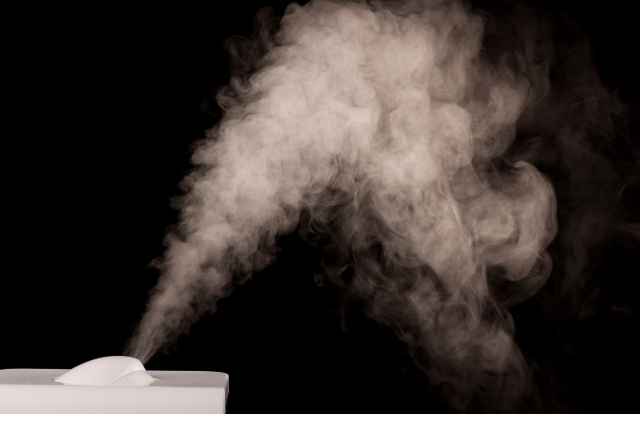
Some parents are tempted to use additives containing menthol and essential oils in their child’s humidifier, and understandably so.
After all, menthol is useful in decongesting nasal passages, alleviating the symptoms of cold and flu, and easing breathing difficulties.
However, these additives can harm kids below three years.
Humidifiers tend to produce large particles of essential oils that your baby can breathe ineffectively.
These can cause irritation of your infant’s mucosa and damage the equipment itself. It’s worth noting that humidifiers can’t disperse oil as effectively as they do with water.
Humidifier Types: Which One Is Right for Your Baby’s Room?
When it comes to selecting a humidifier for your baby’s room, you’ll encounter several types: ultrasonic, evaporative, cool mist, and warm mist. Each type has its pros and cons.
Ultrasonic humidifiers use high-frequency vibrations to create a fine mist. They are quiet and energy-efficient but can leave a white dust if used with hard water.
Evaporative humidifiers use a fan to blow air through a wet wick or filter. They self-regulate the humidity but can be noisy and require regular wick replacements.
Cool mist humidifiers produce a cool mist and are recommended by pediatricians. They are energy-efficient but may require frequent cleaning.
Warm mist humidifiers heat water to create steam. They are generally not recommended for use in a baby’s room due to the risk of burns.
The Ideal Humidity Level for a Baby’s Room
Maintaining the right humidity level in your baby’s room is crucial for their health and comfort. The recommended range is between 40% and 60%. To measure the humidity, you can use a hygrometer, which is an inexpensive device available at most stores.
Proper Humidifier Cleaning and Maintenance
Regular cleaning and maintenance are essential to prevent mold and bacterial growth in your humidifier. Follow the manufacturer’s instructions for cleaning and make sure to replace filters or wicks as needed.
Safety Features to Look for When Purchasing a Humidifier
When choosing a humidifier for your baby’s room, consider the following safety features:
- Automatic shut-off when the water tank is empty
- A timer function to prevent over-humidifying
- A built-in hygrometer for accurate humidity readings
Indoor Plants and Humidity: A Natural Solution
Indoor plants can help increase humidity levels in your baby’s room while also improving air quality. However, ensure they are compatible with humidifiers and are non-toxic to babies.
Alternatives to Humidifiers for Maintaining Humidity
If a humidifier isn’t an option, you can try these alternatives to maintain optimal humidity levels:
- Place a bowl of water near a heat source
- Use a damp towel over a radiator or heater
- Regularly air out the room by opening windows
Common Issues with Humidifiers and How to Address Them
Some common issues with humidifiers include leaking and noise. To address these problems:
- Ensure the water tank is correctly positioned and not overfilled
- Check for loose or damaged parts
- Place the humidifier on a solid, level surface
Proper Room Ventilation: The Key to Healthy Humidity Levels
Maintaining proper room ventilation is essential in preventing issues associated with humidifiers. Ensure adequate airflow by regularly opening windows and using exhaust fans when necessary.
Vaporizers vs. Humidifiers: Which Is Best for Your Baby’s Room?
Vaporizers produce steam by boiling water, while humidifiers release a cool or warm mist. Due to the risk of burns, vaporizers are generally not recommended for use in a baby’s room.
Adjusting Humidifier Settings Based on Outdoor Weather Conditions
Outdoor weather conditions can affect indoor humidity levels. In dry or cold weather, you may need to increase your humidifier’s output. On the other hand, in humid or warm weather, you may need to decrease the output or turn it off altogether.
Final Words
I hope this article has helped you to figure out how close does humidifier need to be to baby
Depending on how you use them, humidifiers can be helpful to or harmful to your baby.
I’m hopeful that the tips mentioned in this article will help you use this vital piece of equipment more effectively.
In summary, the ideal distance between your baby and the humidifier is at least three feet.
Except for dry days, never apply high humidity settings.
Also, ensure that you keep the device and the water inside is clean and free of algae and bacteria.
Lastly, position the humidifiers so that their wiring isn’t exposed and fix any leaks immediately.
READ NEXT
15 Proven Signs Your Baby Will Have Beautiful Curly Hair That You Love
If you’ve ever wondered if your baby will have curly hair, there are signs to…
How to wash baby hair without getting water in the eyes
Babies are sensitive to eye infections and they can cause serious problems in the future….
Top 7 Best Baby Hair Oils for Babies |2022
Baby hair oil is a very important product for babies. It is an essential part…
Coconut Oil for Babies Hair – An Essential Guide
What is Coconut Oil? Coconut oil is a natural hair care product that is used…
9 Best Curly Hair Products for Babies in 2024
If your baby has curly hair, I don’t need to tell you how hard its…
Can a Baby’s Hair Change from Straight to Curly?
One of the common questions that I see in natural hair forums include ‘how come…
15 Proven Signs Your Baby Will Have Beautiful Curly Hair That You Love
If you’ve ever wondered if your baby will have curly hair, there are signs to…
How to wash baby hair without getting water in the eyes
Babies are sensitive to eye infections and they can cause serious problems in the future….
Top 7 Best Baby Hair Oils for Babies |2022
Baby hair oil is a very important product for babies. It is an essential part…
Coconut Oil for Babies Hair – An Essential Guide
What is Coconut Oil? Coconut oil is a natural hair care product that is used…
9 Best Curly Hair Products for Babies in 2024
If your baby has curly hair, I don’t need to tell you how hard its…
Can a Baby’s Hair Change from Straight to Curly?
One of the common questions that I see in natural hair forums include ‘how come…

